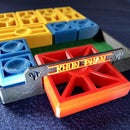Introduction: Pencil Box - Two Levels - Sliding Cover Lock - 3D Printed
Once again I have designed something and sent it to my 3D printer. A "Pencil Box" has come out of it.
I used a wooden one as a template, which I made a few decades ago as part of a training course at the Institute for Teacher Training.
… I thought it might be something for the 3D printing community.
Dimensions:
- L 230 mm
- W 70 mm
- H 55 mm
Files to print:
- Pencil case_bottom.stl
- Pencil case_cover.stl
- Pencil case_top.stl
Print Settings
- Printer brand: Prusa
- Printer: MK3S
- Supports: No
- Resolution: 0,2
- Infill: 15%
- Filament brand: Prusa; Geetech
- Filament color: Galaxy Black; Silky SIlver
- Filament material: PLA
Remark: As all parts are designed to fit very precisely, it may happen that you have to rework one or the other part a bit with sandpaper and/or cutter due to different dimensional accuracy of the printers and the different behavior of the filaments.
Supplies
- 225 x 53 x 3 mm transparent polycarbanate glass
- Can lid with approx. Ø 70-75mm
- Sandpaper
- 1 Phillips screw Ø 4 x 20 mm
- 1 washer Ø 4,5 x Ø 12 mm
- Phillips screwdriver
- Fretsaw (fine saw blade)
If you don't have polycarbonate glass available, you can also print the cover (PencilCase_cover.stl).
Attachments
Step 1: Preparing Sliding Cover
This first step will show you how to make this sliding cover. Of course it is easier to print it. But I like a transparent one better.
For the the polycarbonate lid you need:
- 225 x 53 x 3 mm transparent polycarbanate glass
- Can lid with approx. Ø 70-75mm
- Fretsaw
- Sandpaper
After you have cut the lid, you must saw out a kind of recessed grip on one side. To draw in the rounding I took the lid from a tin can. The diameter of the lid should be between 70 and 75 mm. After sawing out the rounding, you must carefully break all the edges of the lid (grind them round).
Step 2: Assembly
Next, those two parts must be printed first:
- Pencil case_bottom.stl
- Pencil case_top.stl
Further you need now:
- 1 Phillips screw Ø 4 x 20 mm
- 1 washer Ø 4,5 x Ø 12 mm
- Phillips screwdriver
First test whether the sliding lid fits and can be pushed without any problems. If it is too difficult to slide, you will have to grind the edges of the lid to fit with sandpaper.
Now you can screw the top part (Pencil case_top.stl) onto the bottom part (Pencil case_bottom.stl) with a Phillips screw Ø 4 x 20 mm. To prevent the screw head from pressing into the material, use a washer Ø 4.5 x Ø 12 mm.
Tighten the screw only so tight that the top part can still be turned.
Now push the lid into the upper part.
That's it! The pencil case is complete!
Step 3: Color Suggestions
Depending on who this pencil box is intended for, the color design should be varied ... for children perhaps rather more colorful.

Participated in the
Anything Goes Contest 2021
















